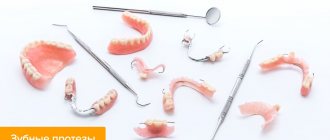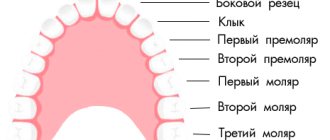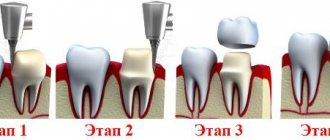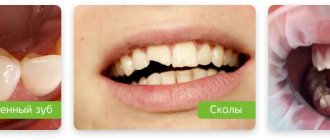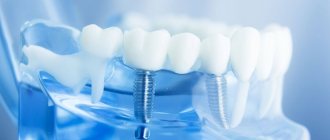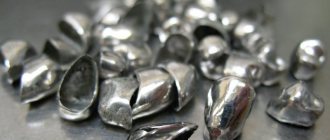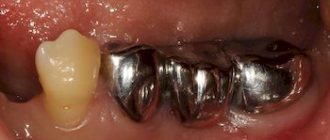We will describe in detail which crowns are best to place on chewing teeth and which on the front teeth. Our specialists have been installing the best crowns at affordable prices for over 25 years.
Many patients, before visiting a specialist, study the types of dental crowns and seek to find out which ones are best suited for each specific situation. Most people rely on forums, others ask their friends questions about the results of prosthetics. Unfortunately, only a few manage to obtain real information.
This article provides comprehensive information regarding the different types of crowns, methods of their manufacture, performance characteristics, service life and pricing policy. We hope that while reading this material you will study in detail the types of crowns on teeth and be able to understand which ones are best suited for a particular area of the jaw.
For everyone who does not know where it is best to put crowns on their teeth , we offer services of the highest level. In our clinic, all procedures are carried out under the guidance of specialists with impressive experience and deep knowledge in the field of prosthetics. In addition, we focus on using only modern durable materials, high-precision dental equipment, and implement effective technological solutions. This allows each patient to count on high-quality and long-lasting treatment results.
Types of Best Dental Crowns for 2022
Modern dentistry offers patients crowns made from various materials. It is this indicator that is key in determining the cost, quality parameters and indications for the use of a particular prosthesis. Another important criterion on which the quality of a product depends is the production method.
The following crowns are currently in demand:
- Metal-ceramic. They are among the most popular prosthetic devices. Includes a metal base and an outer facing layer of ceramics. Initially, the frame is made, after which the ceramic coating is performed. The production process can be carried out on the basis of modern computer programs and aesthetic modeling.
- All-ceramic. In the manufacture of such prostheses, metal-free ceramics are used. Provides maximum safety in relation to soft tissues, which is due to the biological inertness of this material. The manufacturing process is based on the firing technique; ceramic pressing technologies; use of milling equipment and modern digital programs.
- Crowns made of zirconium material. Despite its origin (metal), zirconium dioxide is famous for its unrivaled aesthetics and increased safety. The manufacturing process is based on the use of specialized digital programs and milling equipment. Two versions of such prostheses can be used: combined (include a base of zirconium material and ceramic lining) and monolithic (made of zirconium oxide without the use of a ceramic coating).
- Glass ceramics e.max. It is distinguished by perfect aesthetic parameters and the necessary strength. There are currently 2 material options in use: E.max RPESS - produced by injection molding using elevated pressure and temperature conditions, and E-max CAD - produced using modern digital applications and milling machines (CAD/CAM concept).
Prosthetics with metal-ceramics.
As already noted, metal-ceramics have found their application more in the prosthetics of chewing teeth, where the main thing is strength, not appearance. However, this does not mean that metal ceramics are completely devoid of aesthetics, not at all. The widest range of ceramic coatings allows metal-ceramic crowns to perfectly imitate the shade and structure of natural tooth tissue.
The problem may arise when prosthetics are placed on the front teeth. It is as follows: a dark metal frame can show through a layer of ceramics, that is, the metal simply shines through the translucent coating. Therefore, when replacing anterior teeth, it is most often recommended to use metal-free ceramics or ceramics based on zirconium (zirconium dioxide) - this is, in fact, the same metal ceramics, but the frame material is white metal - zirconium, by the way, is absolutely biocompatible with the human body .
Comparative characteristics of the best crowns
To determine which crowns are the best , you need to study the pros and cons of each product, taking into account the material used.
Next, we will compare the key parameters of various prosthetic options:
| Crown | pros | Minuses |
| Made from metal-ceramics using precious metals | Has increased strength, has a natural appearance, does not cause allergization of the body | High price |
| Made from metal-ceramics using non-precious metals | It is famous for its sufficient strength, has a reasonable price and good aesthetic parameters | There is a possibility of allergy |
| Made of ceramic material | Features impeccable aesthetic parameters and absolute compatibility with the patient’s body | Increased fragility |
| Made of zirconium material | Excellent aesthetic properties, long period of operation, absolute compatibility with the body, absence of allergic reactions | Impressive value |
| e.max crowns | Unsurpassed aesthetics, increased strength, excellent light transmittance. Emax Press has a gradient of color and transparency. | High price. Only single crowns can be installed in the chewing region. |
Metal ceramics VS Metal.
All-metal crowns compare favorably with metal-ceramics in price and are not inferior in structural strength. But there are a few “buts”:
- metal can imitate a natural tooth only in terms of anatomical shape (the “iron teeth” effect);
- metal teeth destroy the teeth they come into contact with, increasing their
What are the best crowns for chewing teeth?
In general, the controversial issue regarding which crown is best to place on chewing teeth may have a completely unambiguous solution. Since this department experiences increased chewing pressure, it is advisable to use high-strength and most reliable prostheses to recreate the missing units. However, despite the need to restore functional characteristics in this area, the aesthetic component should not be ignored. Moreover, making the right choice is also important from the standpoint of the biocompatibility of the material.
Next, you will get acquainted with detailed information regarding which crown is best to place on the chewing teeth, taking into account the material used:
- Metal ceramics . According to statistics, this material is among the most popular in orthopedic practice. First of all, this is due to the excellent quality and affordable prices for such crowns. As for the negative aspects, they include a significant likelihood of chipping, unlike traditional analogues. In addition, there is a risk of cyanosis appearing at the border of the gum and the prosthetic device, which has an undesirable effect on aesthetics;
- Dentures made of ceramic material . The possibility of using such crowns depends on their type. It is undesirable to fix standard ceramic structures in the masticatory region due to their significant fragility and increased likelihood of breakage. However, at the moment it has been possible to develop more durable crowns that make it possible to recreate the missing units in any area of the jaw. These include Emax and Empress glass-ceramic structures. But if you study dental crowns from the point of view of which ones are better, the price in this case is not a priority criterion (over 20,000 rubles per unit);
- Structures made of zirconium material . They allow you to recreate the missing units in the lateral section, since they are considered the most highly durable and durable prostheses. It is recommended to use monolithic crowns, which eliminates the possibility of using a porcelain coating and, as a result, minimizes the possibility of chipping. However, the price of such a prosthetic device can be higher than 30 thousand rubles;
- Emax crowns . Despite the exceptional aesthetics and excellent strength parameters (up to 400 MPa), such crowns are best used for the frontal area. For the chewing region, it is allowed to use single crowns made of E-max RPESS material obtained by pressing.
Advantages and disadvantages of metal ceramics.
Patients who decide to have metal-ceramic prosthetics often ask themselves and their doctor the question: can metal-ceramics cause harm?
If the prosthesis is made by professionals from high-quality certified materials in a laboratory in compliance with relevant standards, then the danger of such prosthetics is minimal and practically eliminated. The materials that are used in the manufacture of metal-ceramic crowns are themselves non-toxic, but, nevertheless, they can behave differently in the oral cavity. For example, nickel in frames made of chromium-nickel alloys can cause an allergic reaction. And structures made from base metals can oxidize over time due to a reaction with saliva.
In general terms, the advantages of metal-ceramic prostheses include their durability and strength, while the disadvantages are the need for deeper treatment of the tissues of a living tooth, as well as exposure of the frame when the gums recede and the metal base is visible through the ceramic (the exception is zirconium crowns).
Strength:
Today, metal-ceramic structures are installed mainly on teeth exposed to significant chewing load, although until quite recently they were used everywhere. Metal-free ceramic crowns, on the contrary, did not enjoy increased popularity due to the fragility of their design, and therefore were mainly used to restore front teeth.
But with the advent of zirconium dioxide frames in dentistry, the situation has changed dramatically. An increasing number of both dentists and patients are inclined to use these new materials for prosthetics of both chewing and frontal teeth.
The ultra-strength of cermets also has a downside. Damage occurs to the teeth in contact with the metal-ceramic prosthesis, which can lead to their premature and excessive wear. Whereas the hardness coefficient of ceramic prostheses based on zirconium dioxide is very close to the hardness coefficient of real teeth, therefore, when in contact with a prosthesis made of metal-free ceramics, the opposing teeth are not injured from the impact load.
Allergy:
Allergies in the design of a metal-ceramic prosthesis are caused not by ceramics, which are hypoallergenic, but by the metals used in the frame. Symptoms of an allergy to metal ceramics may include:
- burning sensation in the gums or tongue;
- metallic taste in the mouth;
- swelling and swelling at the site of contact with the crown.
If you experience any of these phenomena after installing a metal-ceramic crown, contact your dentist immediately. If you are allergic to metal-ceramics, there is a way out - this is replacing the metal-ceramic crown with an all-ceramic metal-free orthopedic structure.
Color:
Dental ceramics allow you to choose any color that perfectly matches the natural color of the patient’s teeth. The shade is carefully selected by the dental technician using a special Vita scale.
A metal-ceramic crown will not change color over time and will not fade because it does not absorb pigment at all, unlike composite materials from which fillings are made. For all the above reasons, metal ceramics do not require special bleaching.
Durability:
The main misconception of happy owners of metal-ceramic prostheses is ignoring the service life of such a structure. All patients are confident that it is enough to install a metal-ceramic crown once and for all, and it will serve for the rest of their lives. Let us immediately refute this false statement; it is not true! No matter how regrettable it may be, the service life of any metal-ceramic prosthesis is limited on average from 5 to 12 years.
The key to the longevity of the prosthesis is its high-quality production using individually and precisely made casts, as well as the patient’s compliance with all recommendations for its care when wearing it.
Dental clinics provide a guarantee for metal-ceramics for a period of one to three years, taking into account the frame material and the clinic’s policy. According to the warranty terms, the crown must maintain its integrity and not be subject to destruction under mechanical influence for a certain period specified in the warranty. The crown may last the stated time, however, remember that the most “popular” reason for the crown to fall out is not its damage, but secondary caries that has developed under the crown. To avoid this situation, do not neglect regular preventive examinations and do not delay replacing worn-out orthopedic structures with new ones.
Ceramic metal, like any other material, has a service life, after which the product made from it wears out and becomes unusable, as it cannot fully perform its functions. Ignoring the service life of metal-ceramic dentures can lead to tooth loss!
An alternative to crowns for chewing teeth
It should be remembered that even in the presence of significant damage, a tooth can be restored using a conventional light-composite filling and pin. If it is necessary to eliminate a single defect, implant fixation is recommended.
Which is preferable: a filling, a pin or a crown?
As mentioned earlier, with significant destruction of the coronal part of the tooth (more than 50%), it is possible to recreate it using a light-composite filling mass. In this case, a pin made of fiberglass or metal material is used, which allows for more reliable fixation of such a filling.
If the tooth crown is destroyed by more than 50%, experts recommend resorting to the use of a prosthesis. This primarily applies to units from which the pulp has been removed, as these are considered the most fragile.
Also, in case of significant destruction of the coronal part, dentists use a special stump insert, which ensures a more durable installation of the prosthesis.
What to choose: a crown or a dental implant?
When considering the replacement of missing units with crowns, implant fixation is the preferred option for eliminating a single defect. When using a dental structure, the need to prepare teeth that act as supporting elements is eliminated. In addition, implants have a longer period of use, in contrast to single prosthetic structures and bridges.
Cost of turnkey installation in Moscow clinics?
The average cost of installing turnkey structures based on precious metals is 8,000 – 10,000 rubles. The average cost of metal-free structures is much higher: 18,000 for pressed ceramics, 20,000 - 23,000 for products based on zirconium dioxide or aluminum oxide.
At the same time, experts note that this cost is justified, since the products are characterized by high aesthetics, safety, and are ready to last for many years.
The price of the service is calculated individually and depends on the status of the clinic, the amount of materials used, the amount of work performed, the qualifications of the dentist and a number of other factors.
The final cost includes all stages of prosthetics: diagnostics, taking impressions, grinding teeth, anesthetic, manufacturing and installation of structures.
Details of how dental impressions are made for prosthetics.
What are the best crowns for front teeth?
When we are trying to figure out how to choose the best crowns for the front teeth, the priority criterion is the aesthetic component. At the same time, prosthetic structures intended for the frontal region must have a natural appearance, fully correspond to natural analogues and have sufficient strength. However, when you plan to fix a crown on the front teeth, there is no point in asking: “Which dentures are better to install on the lower jaw, and which ones on the opposite side?”
In both cases, the same type of prosthetic device models are used. Below we will provide more selected information:
- Metal-ceramic crowns . Despite the reasonable cost, this is not a completely suitable option in terms of aesthetic parameters. Firstly, an undesirable bluish tint appears in the area where the prosthesis adheres to the gum. Secondly, the metal base can be viewed through the ceramic coating. Of course, today there are improved designs with shoulder mass, but their price will significantly exceed the cost of a standard crown;
- Dentures made of ceramic material . This is the most advantageous option in cases where a dilemma arises as to which crowns are best placed in the frontal part of the jaw. Moreover, for this department you can resort to the help of traditional prostheses made of all-ceramic material. Their cost is considered affordable for most patients;
- Zirconium crowns . This solution is considered one of the most expensive when it is necessary to reproduce anterior teeth. However, this option is considered preferable for those who want to find out which crowns are best to put on their front teeth, but for whom pricing policy does not matter;
- Emax crowns . Such designs are made from an improved material - glass ceramics, which has excellent aesthetics. In this case, it is advisable to choose the E-max RPESS Multi material, which has a gradient of color and transparency, which will allow you to recreate the lost frontal units with maximum identity.
Our clinics
Clinic "Elident" on Varshavskaya
Varshavskoe highway, 75, bldg. 1, Moscow 117556
- Varshavskaya (500 m, closed until 2021)
- Nakhimovsky Prospekt (1,300 m)
Mon-Sat : 09:00-21:00; Sun : 09:00-19:00.
Online registration
+7 (495) 649-41-19
Elident Clinic in Annino
Varshavskoe highway, 154, building 1, Moscow 117405
- Annino (500 m)
- Academician Yangelya (700 m)
Mon-Sat : 09:00-21:00; Sun : 09:00-19:00.
Online registration
+7 (495) 649-41-19
Alternative options to frontal crowns
At the moment, there are three alternative methods that allow you to restore the crown part of the tooth, with destruction of no more than 50%. These include:
- Veneers. Suitable for use if there is slight destruction of the outer surface of one of the front teeth. An important requirement for carrying out a procedure using such plates is the preservation of the tooth wall from the inside. Through veneers, unsurpassed aesthetics are achieved, the possibility of tooth preservation is ensured and it is possible to significantly extend the life of the tooth;
- Dental implants. If it is necessary to reconstruct 1-2 teeth and install bridge-like prosthetic devices, it is advisable to fix the implants instead of preparing the supporting units;
- Filling material. As mentioned earlier, the option with light-composite restorations is preferable when the coronal part of the tooth is destroyed by no more than 50%.
What crowns are best to put on implants?
When studying the question of which crowns are best placed on implants, one should remember the classic procedure for installing dentures. If it is necessary to recreate the missing units in the frontal region, experts give preference to the aesthetic component. The best dental crowns in this situation will be made from zirconium material or ceramic.
If you need to fix crowns on your chewing teeth, and you don’t know which ones are better, any experienced dentist will give clear advice - in this area it is advisable to install prosthetic devices made of metal ceramics, zirconium material or e.max glass ceramics. It should also be taken into account that adapters in dental structures, in the event of subsequent use of the above prostheses, must be obtained from materials that are unable to be seen through the ceramic layer.
Many patients are interested in which crowns are better, ceramic or zirconium, to be fixed to implants? According to leading experts, the most advantageous options include devices made from the innovative material E-max or zirconium dioxide.
Additionally, when evaluating whether metal-ceramic or zirconia crowns are better, it is important to consider the need for zirconia adapters. This will prevent the body from becoming allergic to metal, as well as obtain the desired aesthetic result.
What is cermet?
When we say “metal-ceramics,” we most often mean crowns and bridges on a metal frame coated with ceramic. Otherwise, it is an orthopedic base made of metal, repeating the shape of a tooth ground for a crown, which is covered on top with a layer of thin ceramics. Ceramic metal is less likely than other materials to cause allergies. Metal-ceramics are used mainly for dental prosthetics in the chewing region, where preference is given not so much to aesthetic qualities as to reliability and functionality.
Prices for tooth crowns at Elident
When assessing dental crowns from the standpoint of which ones are better financially, one should take into account the material used, the technological solutions being implemented, the equipment used, as well as the level of professionalism of the specialist and the rating of the dental institution in which the teeth are restored.
The Elident clinic has affordable prices for all types of services related to the fixation of implants and the installation of dental crowns. At the same time, you can always count on an individual attitude and high professional training of dentists, which is combined with the use of highly effective innovative equipment and modern prosthetic concepts.
| Service | Price, ₽. |
| Consultation with an orthopedist | for free |
| Orthopantomogram - panoramic image of teeth | 950 |
| Ceramic crown Dutseram plus (Germany) | 20 500 |
| Ceramic crown made of zirconium dioxide | 35 000 25 000 |
| Empress crown | 19 000 |
| Ceramic crown made of zirconium dioxide on an implant | 35 000 |
| Temporary plastic crown/wedge. | 2300/1500 |
| Taking an impression from alginate mass | 400 |
| Diagnostic plaster model | 400 |
| Taking a double impression | 800 |
| Cementing inlays and crowns using Fuji cement | 700 |
| Cementing inlays and crowns using Fuji+ cement | 800 |
| Temporary cementation of one crown | 400 |
| Removing one crown with stamped sawing | 500 |
| Removing one crown with sawing the cast | 1 000 |
| Removing one crown with sawing MK | 800 |
How to install metal ceramics?
Installation of metal ceramics occurs in several stages. First, the patient needs to undergo a general examination, diagnostics and dental treatment, if necessary.
After this, the teeth are prepared for a crown: the enamel is ground down, the nerve is removed (if the condition of the supporting teeth is good, the doctor can leave them alive).
Impressions are taken from the ground teeth, from which individual orthopedic structures are made in the laboratory. Thus, the production and installation of metal-ceramic prostheses takes on average about two weeks.
Keep in mind that grinding for an all-ceramic crown is more gentle, this is due to the thickness of the crown itself (a ceramic crown is thinner). Usually the tooth is not ground down completely; a ledge is formed at the border with the gum, which does not allow the metal frame to come into contact with the gum and, thus, reduces the risks of developing allergies, tissue irritation, bleeding gums and swelling.
Service life of dental crowns
If you are interested in a tooth crown and what material is best for its manufacture, an important point is the service life of the product. For example, prosthetic devices made of metal-ceramics can be used for 8-10 years, zirconium structures - over 15-20 years, glass-ceramic products - over 15 years.
However, when studying the properties of dental crowns and trying to find out which ones are better suited for prosthetics in a particular area of the jaw, one should not forget about compliance with the patient’s care requirements and the quality of the procedure performed by the dentist.
Under normal conditions, assuming proper training of the doctor and strict compliance with the production concept, the service life of crowns cannot be less than 10 years.
Caring for tooth crowns
When studying the topic of dental crowns and trying to understand which ones are better, many rely on reviews from other patients and specialists. At the same time, any qualified doctor will tell you that to extend the life of a prosthetic device, you first need to pay attention to the rules of care.
For example, if you have a single crown installed, it is enough to carry out regular hygiene procedures using toothpaste, brush and dental floss. In the presence of bridge structures, as well as in patients with periodontal pockets in the area of dentures, it is necessary to resort to the help of irrigators. These devices help clean hard-to-reach areas from dental plaque and food debris.
Article expert (author):
